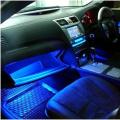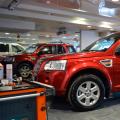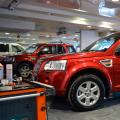For a long time all over the world, many motorists and even experts believe that narrow is much better than wide. Do you also agree with this opinion? Then you should know that recently in Germany, the state organization for technical supervision together with Auto Club Europa (ACE) conducted a test winter tires in order to find out whether narrow rubber in winter period better than similar ones.
Wheels of three different sizes were selected for testing with the same profile of winter tires, which are intended for use in winter, as well as in wet weather. For testing, wheels were selected for BMW 3-series, the following sizes: 16-inch wheels on steel rims R16 (205/55), 17-inch wheels 225/50 and 18-inch (front wheels 225/45 R18, rear 255 / 40 R18).
Many of our readers might think that the test used all season tires, since the rubber marking was indicated by the Latin letters "M + S". In fact, this designation, which is found on many tires on the market today, does not mean that the tires are intended for all-season use. This abbreviation actually stands for Mud and Snow, and is often also used on different types tires for different seasons. We remind you that the designation indicating that tires are intended for winter is traditionally indicated by manufacturers in the form of a "snowflake" icon.
Winter tire test results

As a result of the study, the experts came to the surprising conclusion that narrow tires practically do not have an advantage over wide tires. On the contrary wide tires have in some cases more contact with road surface, which provides much better in contrast to narrow rubber. The particular advantage of wide tires is observed in winter on slopes. So during the test, a car with wide tires on a slope accelerated much faster than another, equipped wheel rims with narrow rubber.
However, experts note that wide tires should not be the first choice for winter operation, since experiments have shown that wide rubber with high humidity lack of balance, resulting in reduced grip. For example, if you disable eSP system on a car with wide tires, you will need significantly more steering wheel effort to maintain traction than on the same car with narrow wheels.
Optimum wheel size 17-inch

Comparisons have shown that the optimal choice should be 17-inch wheels with winter tires, since it is this wheel size that is optimal for driving on snow and wet road... So the experts tested 16, 17 and 18-inch wheels with the same tires and concluded that the 17-inch performs best in the winter.
Also, as a result of the study, it turned out that narrow tires are noticeably inferior in the quality of braking to wide tires on dry asphalt. So experts found that if you accelerate to 100 km / h in a car with narrow tires and brake sharply, then braking distances will be about 47 meters, which is much more than on wide tires.
However, if you use narrow rubber on 17 inch wheels, you can shorten the braking distance. That is why experts recommend buying 17-inch wheels for the winter.
The most lively controversy usually flares up in popular autoforums regarding the width summer tires: some motorists claim that the wider the better, while others, on the contrary, prefer to choose tires of medium profile width. As usual, the truth is somewhere in between - the optimal tire width is different for different operating conditions. But let's talk about everything in order.
What is tire section width? The width of the profile is the distance between the sidewalls of a tire inflated to the rated pressure (when calculating this parameter, elevations on the sidewalls, such as markings, trims, etc., are not taken into account). The profile width does not always correspond to the tread width, but for one tire model a direct relationship is always fulfilled - the wider the profile, the wider the tread.
Based on safety requirements, the tire profile width cannot exceed the landing width of the disc rim by more than 30%.
What does the tire profile width affect?
First of all, the width of the profile (for a specific tire model) determines the width of the tread, and, as a consequence, the area of \u200b\u200bthe contact patch of the tire with the road surface. Well, the latter characteristic, in turn, directly affects handling, directional stability, braking distance, fuel consumption and resistance to aquaplaning.
To the positive properties of a wide tire include: better acceleration and braking parameters, better directional stability (the car holds the road better when cornering on high speed), as well as several better cross-country ability in off-road conditions. And of course, appearance - a wide tire always looks more solid on the car.
The main disadvantages wide tires include reduced resistance to aquaplaning, increased consumption fuel, as well as increased weight (increased load on the suspension) and a higher price.
If we summarize the advantages and disadvantages, then we can come to approximately the following conclusions:
1. If you drive in the city most of the season and don't get carried away extreme driving, as well as if you have a small car (engine displacement up to 2000 cc) - for you rational choice narrow tires are definitely - in the city you will not feel the advantages of a wide tire, but the disadvantages will significantly hit the family budget. At the same time, when leaving on the track, you should take some care when entering sharp turns at speed. However, banal compliance with the Rules road traffic (Traffic rules) will be more than enough.
2. If you often drive on the highway and like to "step on the trigger" , and if, in addition, the engine power allows it - your choice is a wide tire, but at the same time, you will have to be extra careful in the rain and on wet roads - if it gets into a puddle, such a tire will behave worse than its narrower sister.
Have you noticed that there are no numbers in the recommendations above? It's because you need to start the selection of the tire profile width by viewing the vehicle operating instructions , where all the permissible tire sizes that can be installed on your car are indicated (such a list is also found in the tire pressure table glued on the gas tank flap or in the opening driver's door). And the maximum (of the indicated) profile width will be the "wide tire", and the minimum, respectively, will be the "narrow" one.
Fitting tires with a tire width not specified by the manufacturer is extremely unsafe , even if you do not need to use spacers under the wheels - do not play with fire, tires are your safety (and often life).
Have you ever wondered which tires are best for winter driving: narrow or wide? And here driving instructors decided to find out what is preferable for our winter roads.
Experiment
In order not to go into theory, auto instructors invite us to a special testing ground where an experiment is being conducted to test tires of different sizes.
A car was chosen for the experiment Volkswagen Golf 7th generation and nokian tires Hakkapeliita 8 in three sizes:
- 195 / 65R15,
- 205 / 55R16,
- 225 / 45R17.
It should be noted that all three sets of tires were rolled in 100 kilometers before testing at the same training ground.
Before the start of the race, the weight and width of the tires were checked. It turned out that the difference between 195 / 65R15 and 205 / 55R16 is not 10 mm, but 8. To be honest, it was a discovery for us. The heaviest were 225 / 45R17, and this was predictable. The 195 / 65R15 tire is lighter than 225 / 45R17 by as much as 1.7 kilograms. But when checking the weight of the wheel assembly, the difference became already 4.6 kg, that is, in total it turned out to be 18.4 kg. As you can see from the numbers, the main increase comes from the disk.
Handling on snow
The first parameter that was tested was handling on snowy roads. It turns out that the difference when driving on different tires is huge! This is especially true for turns. Note that the road was difficult: snowy, "three-dimensional" and laid through a coniferous forest. 205 / 55R16 tires have excellent handling and control over the car. Neutral understeer, very little turnover rear wheels when gas is released, which is gently extinguished by the stabilizing system. Everything is fast and safe.
The following tires are 195 / 65R15. Our car has become a little nervous, the Golf is trying to skid, sweeping and fast steering movements are required, but after a skid, the car stabilizes for a long time. However, for a front-wheel drive car, so to speak, in "combat" mode, oversteer is beneficial.
We take the widest tires 225 / 45R17. The Golf behaves like a "balanced" 205mm tire. As soon as you increase your speed, there is a kind of deceit.
The car starts to demolish after entering the turn. The car clings to snow and even almost flew to a tree while trying to make a fast circle. In terms of the time to cover the distance, the car performed the worst on these tires.
Results of testing manageability:
- the hatchback's behavior varied greatly depending on the selected set of tires;
- with 195 / 65R15 tires, the Golf got oversteer, often wanted to turn around and didn't behave well in corners;
- 225 / 45R17 tires gave the car understeer and rather low grip;
- 205 / 55R16 tires, so to speak, healed the Golf; the route was passed quickly, calmly and smoothly; the skid started smoothly, that is, it was not a surprise for the driver.
Ice test
Disable ESP before controlling on ice. At 225 / 45R17, there is little grip, the car rushes between skidding and drifting, you have to put pressure on the steering wheel, and the connection to the wheels is often lost. Even at low speed, the car slides with the rear axle, constantly hinting at a turn around its axis.
On the narrow and tall, the 195 / 65R15 Golf feels like it hits the ice. When the speed increases, there is not enough steering, and it is very difficult to achieve slip of the rear wheels.
On 205 / 55R16 tires, the grip is slightly more, the car is more balanced, requires less steering when cornering. The car's behavior is safe.
As a result, we can say that 205 / 55R16 performed very well, and there are no complaints about 195 / 65R15 tires, although you need to steer more, and there is understeer.
225 / 45R17 do not have sufficient grip on ice, a lot of work is required on the steering wheel, the car wants to skid all the time.
Snow tests
On packed snow, the car accelerated faster on 195 / 65R15 tires, but when braking they lost 2.7% or 40 cm to wider wheels. R16s were the most stable in this test.
As a result, acceleration and deceleration results are very close on snow.
Acceleration and braking on ice
"Ice" tests were carried out under almost the same conditions as on snow: sharp acceleration from five to 31 km / h and sharp braking to five km / h. On tires 205 / 55R16, the car perfectly clings to the surface, braking is at the highest level. For narrower tires, the results are the same.
We take on the wide 225 / 45R17. Surprisingly, the car rolls much further, and you can feel it even without measuring instruments.
And now we measure the protrusion of the studs: for 195 / 65R15 - 1 mm, 205 / 55R16 - 1.1 mm, 225 / 45R17 - 0.9 mm. Perhaps the poor braking performance on ice is due to the protrusion of the studs. But, you must agree, the indicators cannot differ by more than two meters!
Bottom line: On ice, the results of 195 / 65R15 and 205 / 55R16 tires are similar (a difference of 2.9%), 225 / 45R17 tires clearly failed braking and adhered extremely poorly to the ice during acceleration.
conclusions
The narrow tires on the ice are quite docile, but in turns lead to sharp breakdowns. The high 65th profile and large side slip make the steering wheel turn strongly even during normal bends. Experts recommend these tires for vehicles with ESP, and when driving on snow, you need to drive very carefully.
The golden mean - so you can say about the 205 / 55R16 kit. According to the results of these tires, all tests were passed for a good grade.
In our case, with a car weighing 1205 kg, this width turned out to be the most optimal. Due to the moderate profile height, the behavior of the machine was understandable.
Wide tires showed themselves from the worst side. Ice tests were completely failed. The large area of \u200b\u200bcontact with the ice led to a small specific pressure of the studs on the surface due to the small mass of the car. In the snow, the car blows away, the steering wheel has to be turned hard, and control over the road is often lost.
Video on how to choose winter tires:
Good luck driving!
The article uses an image from the site dadi-auto.ru
Tires of large sizes are in fashion today, and there is a quite logical explanation for this. High-speed car need good brakesand you can't squeeze them into small wheels. So it turns out that an increase in the diameter of the wheels is partly a forced measure. Thirteen-inch tires are gradually losing ground to 14-inch tires.
And even the most popular foreign-made size 195 / 65R15 in Russia is being gradually replaced by the upcoming 205 / 55R16.
We decided to check how the transition from fifteen to sixteen inches in winter tiresah: what gains and what does the owner lose?
Tires of one model "Nokian-Hakkapelita 5", car " Skoda Octavia A5 ", for which both sizes are standard. The tests were carried out after thorough running-in according to the traditional ZR method. The results of measurements and evaluation are shown in the tables.
As you can see, there was no convincing victory of some tires over others. In some ways the "fifteenth" size was ahead, but the "sixteenth" took its toll in another. Good tireswhether summer or winter is always a compromise. It is almost impossible to improve all properties at the same time. Pulling up some indicators entails a deterioration in others.
What is good about the size 195 / 65R15? These tires have slightly better braking on the snow, noticeably better overclocking on snow and on ice, lateral grip when "shifting" on packed snow. In addition, braking without electronics is more informative, the ride is better, as well as cross-country ability in deep snow.
Where do 16-inches win? There is quite a bit of lateral grip on ice on the verge of sliding, and the advantage increases with the transition to sliding. They also slow down a little better on asphalt and save fuel. Although, what is 100 grams per 100 kilometers? Who will notice the saved liter of fuel when a hundred is spent? The handling is slightly better, but only on ice and asphalt. The more noticeable differences are less noise and a clearer course on asphalt.
But the price of a 16-inch tire significantly exceeds its 15-inch counterpart (on average 6,200 rubles versus 4,700 apiece).
Is the cost of a few percent of the gain on some exercises worth the cost?
Nevertheless, the test clearly showed how a very small change in size affects performance characteristics tires of the same brand.
The fifteenth have some advantage over the sixteenth in snow disciplines. Therefore, we recommend giving them preference if snow-covered roads are the main dish in your "road menu". And those who have to drive more on cleaned and / or icy asphalt should choose wider “low profile” tires. Unless, of course, you pay too much attention to the exterior of the car. After all, the argument "I want!" defies constructive analysis.
It often puts motorists in an uncomfortable position. For some branded products, you have to give a lot of money, and more budget options raise a lot of doubts. True, the issue of buying the "right" tires can be solved quite simply, for this it is enough to read the instructions for the car provided by the manufacturer. As a rule, it indicates not only the typical size of the required tires, but also various options for upgrading your vehicle. Taking into account the recommendations of experts, you can give your vehicle, making it tall and soft. Of course, not all motorists take these data into account, some choose large and wide tires, due to which the car looks more spectacular, others, on the contrary, are used to buying standard size tires. Find out which tires are better in winter: narrow or wide?
Selection of winter tires.
Profile width: what does it affect?
If the motorist is in doubt about buying the most optimal rubber, he must take into account the width of her profile. This value is the distance between the lateral portions of the tire inflated to the point indicated by the manufacturer. Generally, profile size and tread width are not always the same. True, one should take into account the fact that the width and tread directly depend on the width of the profile. Repeatedly car enthusiasts and specialists in the field of auto set up experiments, checking tires of different sizes in the same weather conditions. Some are sure that only wide tires should be chosen, while others prefer only narrow ones. Among the advantages of narrow tires, it is worth noting high specific pressure, as well as less contact with the road. In turn, wide tires benefit from the length of the sipes, which are extremely important at the moment of grip on slippery asphalt.
Experiment
To find out how right the experts are, consider a test that involved different tires. It is worth noting that the tires tested proved their effectiveness not only on snowy asphalt, but also on ice. The grip was tested in the following way: they accelerated on ice, subsequently slowing down, and picked up speed on the snow, then reduced it. As practical studies have shown, the choice of a tire should not depend on the personal preferences of the owner of the car, but on the features of the car's operation and the climate in which it is operated.

Wide wheels proved to be excellent directly on slippery asphalt; they can be used to reduce speed as quickly and efficiently as possible. It was the presence of sipes of sufficient length that ensured excellent grip on ice. True, the car picked up speed of only 30 km / h, while throwing it off only up to 5 km / h. As for the well-rolled snow surface, narrow tires were able to bring much greater benefit, where the ability to have minimal contact with the road was put forward in the first place, making the pressure at the contact point high. Thanks to this, the narrow rubber pushes the snow cover.
Speaking about buying the most optimal pair of tires for the winter, it is worth considering the handling of the vehicle on a road covered with snow. As practice shows, the difference when driving on different tires is simply colossal. The easiest way to tell the difference between wide and narrow tires is when cornering. The narrowest tires provide excellent handling, they allow it completely. When cornering, the car behaves calmly, the movement is extremely fast and safe. If the same car is equipped with a set of wider tires, handling on a snowy road takes on a completely different color. The motorist can feel the nervous behavior of the car, its attempts to skid. We should also note the dynamics of acceleration, as it is practically the same on a snowy road.

Ice test
Driving onto an ice-covered winter road, it is difficult to say which rubber is better - wider or narrower. To adequately assess the performance of the two types of tires, it is worth using expert data. It is much more difficult to accelerate on narrow tires, it will take 3.84 seconds, the second tires need less time, they reach fifty km / h. in 3.55 sec. Speaking directly about the braking properties, we can say that they do not differ much from each other. The speed reduction on narrow tires will take place after 17.91 m, while on wide tires - after 17.62 m.
Snow tests
If a motorist is perplexed as to why narrow tires are better in winter, he should learn about the results of the experiment, familiarize himself with the data that unambiguously indicate the superiority of the tire under consideration. According to the results of the study, on a snow-covered road with narrow tires, a vehicle will accelerate to fifty kilometers per hour in no more than 3.66 seconds. A car with larger tires will take the same amount of time, however, when the speed decreases, narrow tires will slow down after 27.11 seconds, and wide tires - in 28.99 seconds.
Acceleration and braking on ice
To decide unambiguously which tires better in winter - narrow or wide, it is worth learning about the indicators that the wheels participating in the experiment provided to the specialists. The mid-profile wheel makes it easier to grip the ice surface, providing excellent braking results.

Positive and negative sides of a narrow tire
To summarize and understand which tires are better in winter - narrow or wider, it is worth noting their advantages. Studies have shown that narrow tires are more stable on ice, although when cornering they can lead to a sharp break. High-profile tires are preferred for those vehiclethat have ESP. However, a motorist should not relax while driving on a snowy road.
When should you choose wide tires?
It is better not to wear wide tires on your car in winter, unless you need to regularly drive on a road covered with ice. Such rubber adheres to the road as closely as possible, contacting with ice at a low specific pressure. On snowy roads, a car with such tires can drive in different directions, demolish, which requires the driver's attention, a strong impact on steering and ultimate control of the road.
Mas Motors



